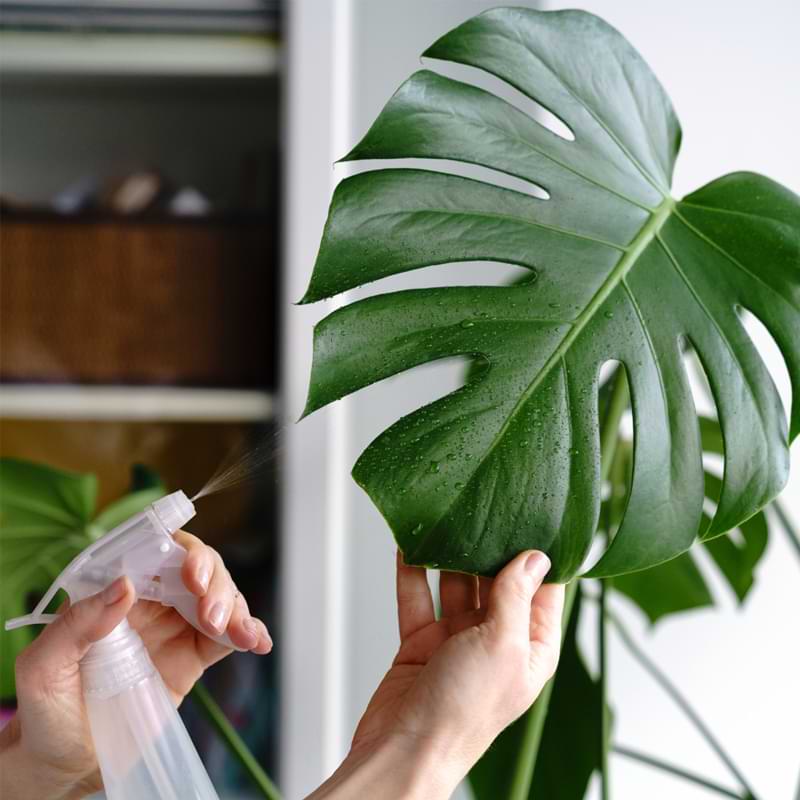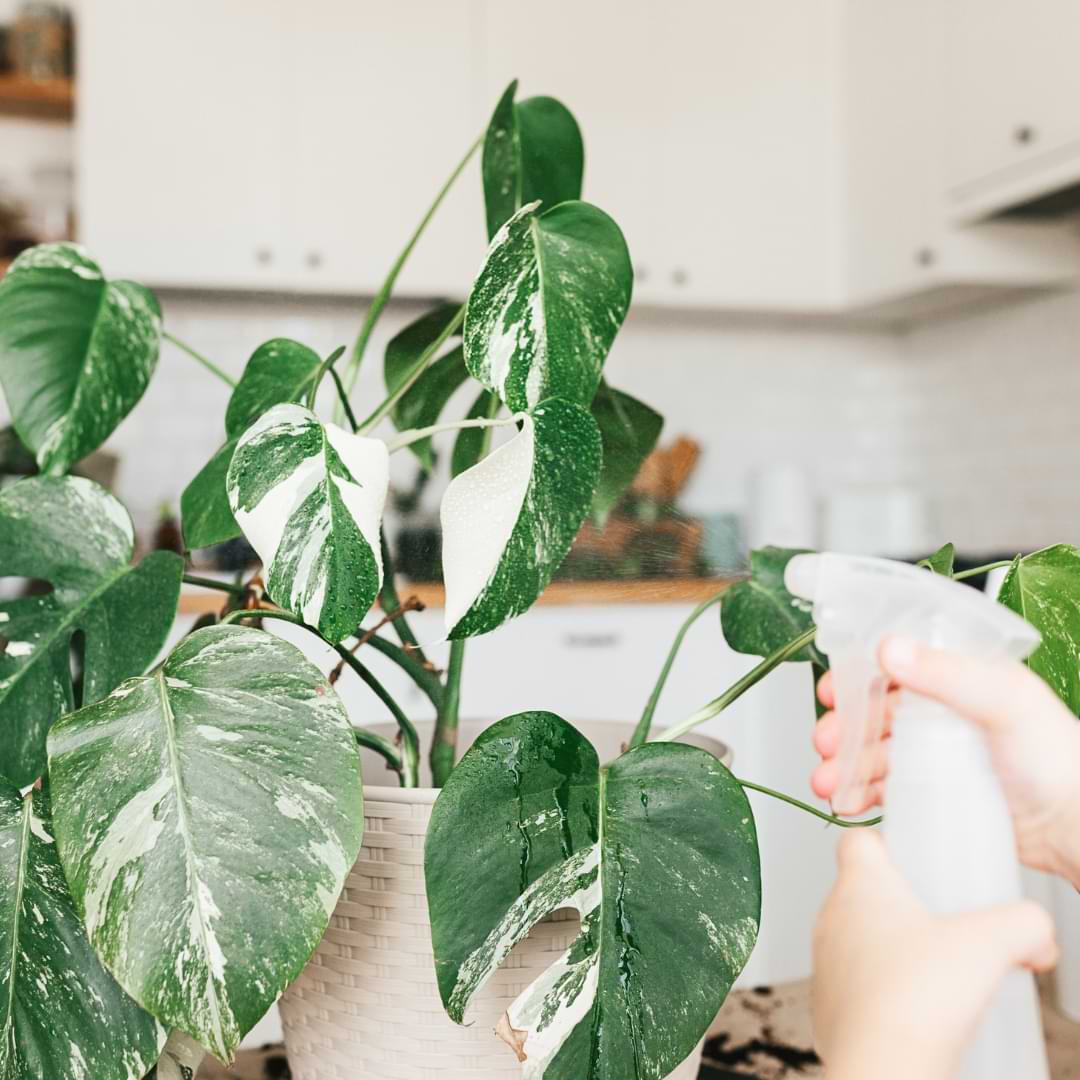You may have heard about the benefits of misting to improve humidity levels, but is misting really necessary for your leafy friend? There are many pros and cons of misting your Monstera, as well as alternative methods for maintaining optimal humidity levels for your Monstera, so let’s take a closer look!
Table of Contents
What Does Misting Do for Plants
Misting is a popular method of increasing humidity levels for indoor plants, including the beloved Monstera. But what exactly does misting do for your leafy friend? Essentially, misting involves spraying water droplets on the foliage and surrounding air to increase moisture levels.
Benefits
When you mist your Monstera plant, the water droplets can settle on its leaves and stem, providing a temporary source of hydration. This can be especially beneficial in dry environments or during winter months when indoor heating can reduce humidity levels.
In addition to helping with hydration, misting can also help remove dust particles from your Monstera’s leaves and improve their overall appearance. Plus, it can create a lovely visual effect as the mist settles around your plant!
Moreover, misting your Monstera plant gives you an opportunity to inspect its foliage regularly for any signs of pests or diseases. Consistent monitoring allows you to notice problematic symptoms early and take appropriate measures before they spread throughout the entire plant. Misting also creates a refreshing environment for both you and your plants while adding moisture into dry indoor spaces – hence promoting healthier air quality overall.
However, it’s important to note that misting alone may not be enough to meet all of your Monstera’s humidity needs, and there are some possible issues that may come up by misting your plant.
Potential Issues
One issue is that over-misting can lead to fungal growth on the leaves and root rot in the soil. Leaves that constantly have little droplets of water on them are optimal breeding grounds for different fungi and bacteria. Root rot happens when the soil doesn’t have enough time to dry out between watering and misting sessions, creating an environment conducive for fungus growth in the soil and on the roots.
Another issue is that if you live in a particularly dry climate or have low-quality water, misting may not be effective at all. In these cases, it’s best to explore other methods of boosting humidity levels such as using a humidifier or grouping tropical plants together.
Frequent misting can also lead to water spots on leaves which can affect their ability to absorb sunlight effectively. Be sure to wipe down any excess moisture from leaves after misting, and don’t allow the sun to reach your leaves until the water has been either wiped off or evaporated, as the water droplets will act like a magnifying glass, and could potentially burn your Monsteras beautiful leaves.

Humidity Requirements for Monstera
When there isn’t enough moisture in the air, plants will lose water through their leaves faster than they can absorb it from roots. This process is called transpiration which helps regulate temperature, and if not balanced with adequate water intake, your Monstera could become dehydrated. So, how much humidity do they actually need?
Native Environment for Monstera
The Monstera plant is native to the tropical rainforests of Central and South America. It thrives in warm, humid environments with plenty of sunlight. These plants can grow up to 10 feet tall in their natural habitats, and are used to fairly high levels of humidity most of the time. The humidity levels in these rainforests range from 70% to 100%, which is much higher than most homes or offices.
In its native environment, the Monstera plant grows under the canopy of larger trees, where it receives filtered light rather than direct sunlight. The thick leaves help protect the plant from harsh rays while still allowing for photosynthesis. Additionally, the soil in these environments tends to be rich in organic matter and well-draining, providing optimal conditions for root development.
Best Indoor Conditions for Monstera
The best indoor conditions for your Monstera are those that most closely resemble their natural environment. While this is nearly impossible inside a home, you can create a microclimate in your Monstera’s immediate area to better mimic these conditions.
Keep the temperature around your Monstera between 65 and 90 degrees Fahrenheit, with a humidity level of at least 60%. Allowing your plant to get intermittent filtered sunlight will also significantly help you plant grow like it would in the rainforest.
Signs Your Monstera Needs Higher Humidity
If the air in your home is too dry, your Monstera may show signs of stress. The most common signs are:
- Brown tips on leaves
- Wilting or drooping leaves
- Yellowing or browning leaves
- Stunted growth
If you notice any of these signs in your Monstera plant, it’s usually a sign that it’s time to increase the humidity level!
Maintaining Humidity at Home
Maintaining humidity at home is crucial for indoor plants like Monstera, as it mimics their natural habitat and helps them thrive. Here are some tips to keep the air moist:
1. Misting
Misting is one of the most common ways to add moisture to your Monstera plant’s environment. However, misting alone may not be enough to maintain consistent humidity for your Monstera. The water droplets evaporate quickly, meaning you need to repeat the process frequently throughout the day.
2. Placing Plants in a Humid Room
Placing your Monstera plant in a humid room is another effective way to maintain the desired humidity level. However, it is important to note that not all rooms are created equal when it comes to humidity levels. Bathrooms and kitchens, for example, tend to have higher humidity due to frequent use of water, but may lack the required lighting to keep your Monstera happy.
3. Grouping Tropical Plants Together
Grouping tropical plants together is another way to maintain humidity levels in your home and keep your Monstera healthy. When you group them together, they create their mini microclimate that mimics their natural habitat. The moisture released by one plant will benefit the others around it.
Not only does grouping tropical plants together help with humidity levels, but it also creates a beautiful display of greenery in your home. You can mix different types of tropical plants with varying textures and colors for an eye-catching arrangement. When grouping your Monstera with other tropical plants, make sure they have similar care requirements. This way, you won’t accidentally overwater or underwater any of them when caring for one plant.
4. Putting Pebbles in the Drip Tray
Putting pebbles in the drip tray is a great way to maintain humidity for your Monstera plant. This method works by adding some water into the drip tray and covering it with a layer of pebbles for the pot to sit on, keeping the pot out of the water, but still creating an area for water to evaporate from.
When you water your Monstera, excess moisture will trickle down through the soil and collect in the drip tray. The water evaporates from the surface of the pebbles, increasing humidity levels around the plant.
One benefit of using this method is that it prevents root rot since excess water does not sit directly on top of the roots. Additionally, putting pebbles in your drip tray helps to keep pests away from your plants as some do not like damp environments. There are others that thrive in damp environments, though, so make sure to keep a close eye on your plant’s health when using this method.
It’s important to note that while this method can help increase humidity levels, it may not be enough if additional factors such as low light or dry air are present. You should also ensure that you don’t overfill the tray with water as this can lead to stagnant water which could potentially attract mosquitoes.
If you prefer not to use a drip tray with your plants, you can always use a decorative humidity tray to achieve the same effect.
5. Using A Humidifier
Using a humidifier is one of the best ways to maintain humidity levels for your Monstera. Humidifiers add moisture to the air and can help create an ideal growing environment for your plants. When choosing a humidifier, make sure you select one that’s appropriate for the size of your space. A larger room will require a more powerful humidifier than a small office or bedroom.
It’s also important to keep in mind that too much humidity can lead to mold growth and other issues, so it’s essential to monitor the humidity level regularly and adjust accordingly.
One advantage of using a humidifier is that it helps improve indoor air quality by minimizing airborne pollutants like dust and allergens. Plus, having proper humidity levels can reduce dry skin and respiratory irritations.
They are also easy to use – simply fill up the water tank, turn on the device, and let it do its job! Make sure you clean it regularly according to manufacturer instructions to prevent bacteria buildup. Using a humidifier is an effective way of maintaining optimal conditions for your Monstera plant as well as improving overall health in your home or office space, and it’s one of the favorite methods used among houseplant enthusiasts to maintain proper humidity levels for houseplants.
FAQ Misting Monstera
When is the best time of day to mist Monstera?
The truth is, there isn’t necessarily a “best” time of day to mist your Monstera – it really depends on your schedule and routine. Some people prefer to mist their plants in the morning as part of their daily plant care routine. This can be a great way to start the day and ensure that your Monstera has enough moisture throughout the day.
Others prefer to mist their plants in the evening after they’ve finished working or studying for the day. This can be a relaxing activity before winding down for bed, and can also help provide some extra humidity overnight.
Ultimately, what’s most important is that you’re consistent with misting your Monstera and paying attention to its needs. If you notice dryness or wilting during certain times of day, adjust accordingly by giving it an extra spritz when needed.
If your Monstera sees unfiltered sunlight at any point in the day, try not to mist around that time.
How often should I mist my Monstera plant?
This depends on several factors, like the temperature and humidity of your home, as mentioned above. Generally speaking, 2-3 times per week should suffice but monitor the leaves regularly and adjust accordingly if they appear dry or yellowed. Misting every day may be necessary if the air is particularly dry.
More Monstera Resources
Remember to check out these resources to improve your monstera care skills and knowledge and grow the most beautiful monstera plants around!





